Mordovia
The Republic of Mordovia (Russian: Респу́блика Мордо́вия; Moksha: Мордовия Республиксь, Mordovija Respublikś; Erzya: Мордовия Республикась,[13] Mordovija Respublikaś) is a federal subject of Russia (a republic) in Eastern Europe. Its capital is the city of Saransk. As of the 2010 Census, the population of the republic was 834,755.[8] Ethnic Russians (53.1%) and Mordvins (39.8%) account for the majority of the population.
Republic of Mordovia | |
|---|---|
| Республика Мордовия | |
| Other transcription(s) | |
| • Moksha | Мордовия Республикась |
 Flag  Coat of arms | |
| Anthem: State Anthem of the Republic of Mordovia[1] | |
.svg.png.webp) | |
| Coordinates: 54°26′N 44°27′E | |
| Country | Russia |
| Federal district | Volga[2] |
| Economic region | Volga-Vyatka[3] |
| Capital | Saransk[4] |
| Government | |
| • Body | State Assembly[5] |
| • Head[5] | Artyom Zdunov[6] |
| Area | |
| • Total | 26,200 km2 (10,100 sq mi) |
| • Rank | 68th |
| Population | |
| • Estimate (2018)[9] | 805,056 |
| • Rank | 60th |
| • Urban | 60.4% |
| • Rural | 39.6% |
| Time zone | UTC+3 (MSK |
| ISO 3166 code | RU-MO |
| License plates | 13, 113 |
| OKTMO ID | 89000000 |
| Official languages | Russian;[11] Mordvin (Moksha and Erzya)[12] |
| Website | http://www.e-mordovia.ru/ |
History
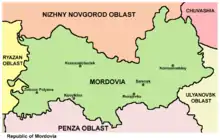
Early history
The earliest archaeological signs of modern humans in the area of Mordovia are from the Neolithic era. Finnic Mordvins are mentioned in written sources from the 6th century. Later, Mordvins were under the influence of both Volga Bulgaria and the Kievan Rus. Mordvin princes sometimes raided Muroma and Volga Bulgaria and often despoiled each other's holdings.
Mongol rule
The Mongols conquered vast areas of Eastern Europe in the 13th century. They established the Khanate of the Golden Horde in 1241, subjugating the area of Mordovia. Mordvins fought against Mongols and later alongside Russians. Mordvin lands territorially belonged to Mukhsha Ulus. The Golden Horde disintegrated in the 1430s, which resulted in some Mordvins becoming subjects of the Khanate of Kazan, whereas others were incorporated into Muscovy.
Part of the Russian Empire
After Ivan IV of Russia annexed the Khanate of Kazan in 1552, the Mordvin lands were subjugated by the Russian monarchy. The Mordvin elite rapidly adopted the Russian language and Russian customs, whereas 1821 saw the publication of the New Testament in Erzya to address the non-elite population. In rural areas, the Mordvin culture was preserved. Russians started to convert Mordvins to Orthodox Christianity in the mid-18th century. Mordvins gave up their own shamanist religion only slowly, however, and many of shamanist features were preserved as parts of local culture, though the population became nominally Christian. Translations of literature to Mordvin languages were mostly religious books. In the 18th century, the Latin alphabet was used to write Mordvin, but from the mid-19th century, Cyrillic was used.
Part of the Soviet Union
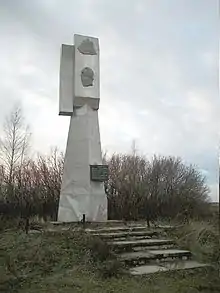
During the Russian revolution and civil war, Mordovia was held by Bolsheviks from the beginning of the war. When the Bolsheviks prevailed in the war, Mordovia became a part of the Russian SFSR. In 1925, the Soviet government founded autonomous districts and village councils in the area of the Mordvins. During the Soviet era, two written languages were developed, one based on the Erzya dialect in 1922 and one on the Moksha dialect in 1923, both using Cyrillic script. The Mordovian Okrug was founded on July 16, 1928, and it was elevated to the status of an autonomous oblast becoming the Mordovian Autonomous Oblast on January 10, 1930. The autonomous oblast was transformed into the Mordovian Autonomous Soviet Socialist Republic on December 20, 1934.[14] Several forced labor Gulags were established under the Bolsheviks, such as Temlag.
Part of the Russian Federation
When the Soviet Union disintegrated, the Mordovian ASSR proclaimed itself the Mordovian Soviet Socialist Republic in 1990 and remained a part of the Russian Federation. Mordovia was one of only two republics that did not proclaim sovereignty.[15] On January 25, 1994, it was renamed the Republic of Mordovia.
Geography
The republic is located in the eastern part of the East European Plain of Russia. The western part of the republic is situated in the Oka–Don Plain; its eastern and central parts are located in the Volga Upland.
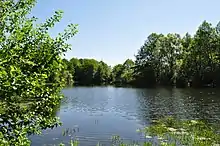
- Area: 26,200 square kilometers (10,100 sq mi)
- Borders:
- internal: Nizhny Novgorod Oblast (N), Chuvash Republic (NE/E), Ulyanovsk Oblast (E/SE), Penza Oblast (S/SW), Ryazan Oblast (W/NW)
- Highest point: 324 meters (1,063 ft) (crossing of the road from Bolshoy Maresev with the roads to Mokshaley, Pyaigiley, and Picheury)
Rivers
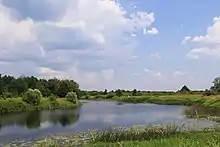
There are 114 rivers in the republic. Major rivers include:
- Alatyr River (Erzya: Rator)
- Issa River
- Moksha River
- Satis River
- Sivin River
- Sura River
- Vad River
Lakes
There are approximately five hundred lakes in the republic.
Natural resources
Natural resources include peat, mineral waters, and others.
Climate
The climate is moderately continental.
- Average January temperature: −11 °C (12 °F)
- Average July temperature: +19 °C (66 °F)
- Average annual precipitation: ~500 millimeters (20 in)
Politics
.jpg.webp)
The supreme law is the Constitution of the Republic of Mordovia.
During the Parade of Sovereignties among other former Russian autonomous republics, Mordovia established a presidency in 1991.
In that same year, Vasily Guslyannikov, a physicist by training, was elected in the general election. Guslyannikov had previously been a senior researcher at the Institute of Power Electronics and was the leader of the republican branch of the Democratic Russia political movement.
In 1993, the Supreme Council of Mordovia abolished the post of president, on the basis of which Guslyannikov was removed from his post. Guslyannikov appealed the action of the supreme legislative body of the republic in the Russian Constitutional Court, but the Constitutional Court declared its conformity with the Constitution of Russia.
The head of the government in the Republic of Mordovia is the Head of the Republic. The office is currently held by Artyom Zdunov, who was made acting head on 18 November 2020. His predecessor was Vladimir Volkov who held the office from 2012.
The State Assembly is the legislature of the republic.
Economy
The most developed industries are machine construction, chemicals, woodworking, and food industries. Most of the industrial enterprises are located in the capital Saransk, as well as in the towns of Kovylkino and Ruzayevka, and in the urban-type settlements of Chamzinka and Komsomolsky.
The largest companies in the region include Unimilk (branch of Danone Russia), Ruzayevsky Chemical Machine-Building Plant, Mordovcement, Saranskkabel.[16]
Demographics
The population of Mordovia is 834,755 (2010 Census);[8] .
Settlements
Largest cities or towns in Mordovia 2010 Russian Census | |||||||||
|---|---|---|---|---|---|---|---|---|---|
| Rank | Administrative Division | Pop. | |||||||
 Saransk  Ruzayevka |
1 | Saransk | City of republic significance of Saransk | 297,415 | |||||
| 2 | Ruzayevka | Ruzayevsky District | 47,523 | ||||||
| 3 | Kovylkino | Kovylkinsky District | 21,307 | ||||||
| 4 | Komsomolsky | Chamzinsky District | 13,513 | ||||||
| 5 | Zubova Polyana | Zubovo-Polyansky District | 10,338 | ||||||
| 6 | Krasnoslobodsk | Krasnoslobodsky District | 10,151 | ||||||
| 7 | Chamzinka | Chamzinsky District | 9,463 | ||||||
| 8 | Romodanovo | Romodanovsky District | 9,410 | ||||||
| 9 | Ardatov | Ardatovsky District | 9,400 | ||||||
| 10 | Torbeyevo | Torbeyevsky District | 9,373 | ||||||
Vital statistics
- Source: Russian Federal State Statistics Service Archived April 12, 2008, at the Wayback Machine
| Average population (x 1000) | Live births | Deaths | Natural change | Crude birth rate (per 1000) | Crude death rate (per 1000) | Natural change (per 1000) | Fertility rates | |
|---|---|---|---|---|---|---|---|---|
| 1970 | 1 026 | 15 423 | 9 048 | 6 375 | 15.0 | 8.8 | 6.2 | |
| 1975 | 1 003 | 14 983 | 9 689 | 5 294 | 14.9 | 9.7 | 5.3 | |
| 1980 | 984 | 14 320 | 10 287 | 4 033 | 14.6 | 10.5 | 4.1 | |
| 1985 | 964 | 15 123 | 11 152 | 3 971 | 15.7 | 11.6 | 4.1 | |
| 1990 | 963 | 12 910 | 11 018 | 1 892 | 13.4 | 11.4 | 2.0 | 1,87 |
| 1991 | 961 | 11 537 | 11 079 | 458 | 12.0 | 11.5 | 0.5 | 1,73 |
| 1992 | 961 | 10 215 | 11 574 | - 1 359 | 10.6 | 12.0 | - 1.4 | 1,55 |
| 1993 | 959 | 9 276 | 13 217 | - 3 941 | 9.7 | 13.8 | - 4.1 | 1,42 |
| 1994 | 956 | 8 916 | 14 748 | - 5 832 | 9.3 | 15.4 | - 6.1 | 1,37 |
| 1995 | 952 | 8 589 | 13 460 | - 4 871 | 9.0 | 14.1 | - 5.1 | 1,32 |
| 1996 | 946 | 7 883 | 13 579 | - 5 696 | 8.3 | 14.4 | - 6.0 | 1,22 |
| 1997 | 939 | 7 493 | 13 631 | - 6 138 | 8.0 | 14.5 | - 6.5 | 1,16 |
| 1998 | 931 | 7 469 | 13 116 | - 5 647 | 8.0 | 14.1 | - 6.1 | 1,16 |
| 1999 | 923 | 6 994 | 14 200 | - 7 206 | 7.6 | 15.4 | - 7.8 | 1,09 |
| 2000 | 913 | 7 148 | 14 838 | - 7 690 | 7.8 | 16.2 | - 8.4 | 1,12 |
| 2001 | 903 | 7 049 | 14 200 | - 7 151 | 7.8 | 15.7 | - 7.9 | 1,11 |
| 2002 | 891 | 7 131 | 14 918 | - 7 787 | 8.0 | 16.7 | - 8.7 | 1,12 |
| 2003 | 880 | 7 433 | 15 170 | - 7 737 | 8.4 | 17.2 | - 8.8 | 1,16 |
| 2004 | 873 | 7 689 | 14 768 | - 7 079 | 8.8 | 16.9 | - 8.1 | 1,20 |
| 2005 | 865 | 7 394 | 14 823 | - 7 429 | 8.5 | 17.1 | - 8.6 | 1,14 |
| 2006 | 858 | 7 367 | 13 981 | - 6 614 | 8.6 | 16.3 | - 7.7 | 1,14 |
| 2007 | 851 | 7 728 | 13 320 | - 5 592 | 9.1 | 15.6 | - 6.6 | 1,19 |
| 2008 | 846 | 8 215 | 13 167 | - 4 952 | 9.7 | 15.6 | - 5.9 | 1,28 |
| 2009 | 841 | 8 103 | 13 027 | - 4 924 | 9.6 | 15.5 | - 5.9 | 1,27 |
| 2010 | 835 | 7 974 | 13 106 | - 5 132 | 9.5 | 15.7 | - 6.1 | 1,24 |
| 2011 | 830 | 7 896 | 12 310 | - 4 414 | 9.5 | 14.8 | - 5.3 | 1,25 |
| 2012 | 822 | 8 180 | 11 925 | - 3 745 | 10.0 | 14.5 | - 4.5 | 1,32 |
| 2013 | 815 | 8 256 | 12 095 | - 3 839 | 10.1 | 14.8 | - 4.7 | 1,37 |
| 2014 | 811 | 8 133 | 11 621 | - 3 488 | 10.0 | 14.3 | - 4.3 | 1,37 |
| 2015 | 808 | 7 864 | 11 431 | - 3 567 | 9.7 | 14.2 | - 4.5 | 1,36 |
| 2016 | 808 | 7 975 | 11 367 | - 3 392 | 9.9 | 14.1 | - 4.2 | 1,40 |
| 2017 | 806 | 6 884 | 10 849 | - 3 965 | 8.5 | 13.5 | -5.0 | 1,26 |
Ethnic groups
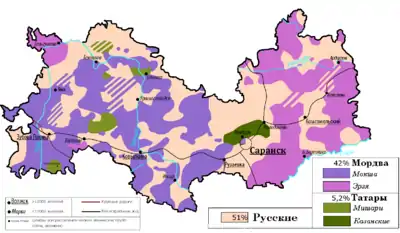
The Mordvin people are a Volga Finnic group speaking two related languages, Moksha and Erzya. The Mordvins identify themselves as separate ethnic groups:[17] the Erzya and Moksha. Only one-third of all Mordvinic languages speakers live in the Republic of Mordovia. During the Soviet period, school textbooks were published in each language.[18]
According to the 2010 Census,[8] Russians make up 53.4% of the republic's population, while ethnic Erzya and Moksha are only 40%. Other groups include Tatars (5.2%), Ukrainians (0.5%), and a host of smaller groups, each accounting for less than 0.5% of the total population.
| Ethnic group |
1939 census | 1959 census | 1970 census | 1979 census | 1989 census | 2002 census | 2010 census1 | |||||||
|---|---|---|---|---|---|---|---|---|---|---|---|---|---|---|
| Number | % | Number | % | Number | % | Number | % | Number | % | Number | % | Number | % | |
| Russians | 719,117 | 60.53 | 590,557 | 59.04 | 606,817 | 58.94 | 591,212 | 59.75 | 586,147 | 60.83 | 540,717 | 60.84 | 443,737 | 53.05 |
| Mordvins | 405,031 | 34.09 | 357,978 | 35.79 | 364,689 | 35.42 | 338,898 | 34.25 | 313,420 | 32.53 | 283,861 | 31.94 | 333,112 | 39.83 |
| Tatars | 47,386 | 3.99 | 38,636 | 3.86 | 44,954 | 4.37 | 45,765 | 4.63 | 47,328 | 4.91 | 46,261 | 5.21 | 43,392 | 5.19 |
| Ukrainians | 7,586 | 0.64 | 6,554 | 0.66 | 6,033 | 0.59 | 5,622 | 0.57 | 6,461 | 0.67 | 4,801 | 0.54 | 4,801 | 0.57 |
| Others | 8,884 | 0.75 | 6,468 | 0.65 | 7,069 | 0.69 | 8,012 | 0.81 | 10,148 | 1.05 | 13,126 | 1.48 | 11,361 | 1.36 |
| TOTAL | 1,188,004 | 100.00 | 1,000,193 | 100.00 | 1,029,562 | 100.00 | 989,509 | 100.00 | 963,504 | 100.00 | 888,766 | 100.00 | 836,403 | 100.00 |
| 1 3,153 people were registered from administrative databases, and could not declare an ethnicity. It is estimated that the proportion of ethnicities in this group is the same as that of the declared group.[19] | ||||||||||||||
Religion
According to a 2012 survey,[20] 68.6% of the population of Mordovia adhere to the Russian Orthodox Church (there are many churches and monasteries, for example, Monastery of John the Evangelist in Makarovka), 5% are unaffiliated Christians, 2% are Muslims, 1% are Old Believers. In addition, 10% of the population declares to be "spiritual but not religious", 7% is atheist, and 6.4% follow buddhism only in the city of Saransk.[20] Some Mordvins adhere to the Mordvin native religion.
Education
The most important facilities of higher education include Mordovian State University and Mordovian State Pedagogical Institute in Saransk.
Culture
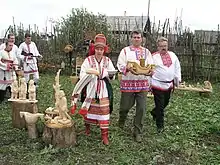
There are many museums in the republic. The largest ones include the Mordovian Republican United Museum of Regional Studies and the Museum of Mordvinian Culture in Saransk.
The National Library of the Republic of Mordovia is the largest library in the republic.
The State Puppet Theater of the Republic of Mordovia, located in Saransk, is well known in Russia. Most of the plays played in this theater are Russian fairy-tales.
Erzya literature experienced a renaissance in the 1920s and 1930s.
The House and Museum of F. Sychkov was opened on March 11, 1970, at Kochelaevo, Kovylkinsky District after a reconstruction.
Mordovian cuisine is widespread in the country.
Sport
Mordovia, along with neighbour Chuvashia and Penza Oblast, has given some of the best modern racewalking athletes, both women (Olga Kaniskina, Anisya Kirdyapkina, Elena Lashmanova, Olena Shumkina, Irina Stankina) or men (Sergey Bakulin, Valeriy Borchin, Stanislav Emelyanov, Vladimir Kanaykin, Sergey Kirdyapkin, Sergey Morozov, Denis Nizhegorodov, Roman Rasskazov), apart from Alexei Nemov (see more in the article History of Mordovian sport).
Language
The Mordvinic languages,[22] alternatively Mordvin languages,[23] or Mordvinian languages, (Russian: Мордовские языки, Mordovskiye yazyki, the official Russian term for the language pair)[24] are a subgroup of the Uralic languages, comprising the closely related Erzya language and Moksha language.[25] Previously considered a single "Mordvin language",[26] it is now treated as a small language grouping consisting of just two languages. Due to differences in phonology, lexicon, and grammar, Erzya and Moksha are not mutually intelligible, so the Russian language is often used for intergroup communications.
The two Mordvinic languages also have separate literary forms. The Erzya literary language was created in 1922 and the Mokshan in 1923.[27]
The two Mordvinic languages are official languages of Mordovia alongside Russian.
See also
- Music in Mordovia
- History of Mordovian sport
References
Notes
- Law #50-Z
- Президент Российской Федерации. Указ №849 от 13 мая 2000 г. «О полномочном представителе Президента Российской Федерации в федеральном округе». Вступил в силу 13 мая 2000 г. Опубликован: "Собрание законодательства РФ", No. 20, ст. 2112, 15 мая 2000 г. (President of the Russian Federation. Decree #849 of May 13, 2000 On the Plenipotentiary Representative of the President of the Russian Federation in a Federal District. Effective as of May 13, 2000.).
- Госстандарт Российской Федерации. №ОК 024-95 27 декабря 1995 г. «Общероссийский классификатор экономических регионов. 2. Экономические районы», в ред. Изменения №5/2001 ОКЭР. (Gosstandart of the Russian Federation. #OK 024-95 December 27, 1995 Russian Classification of Economic Regions. 2. Economic Regions, as amended by the Amendment #5/2001 OKER. ).
- Constitution of the Republic of Mordovia, Article 109
- Constitution of the Republic of Mordovia, Article 9.3
- "Putin appointed Artyom Zdunov Acting Head of Mordovia". Vedomosti (in Russian). November 18, 2020. Retrieved November 18, 2020.
- Федеральная служба государственной статистики (Federal State Statistics Service) (May 21, 2004). "Территория, число районов, населённых пунктов и сельских администраций по субъектам Российской Федерации (Territory, Number of Districts, Inhabited Localities, and Rural Administration by Federal Subjects of the Russian Federation)". Всероссийская перепись населения 2002 года (All-Russia Population Census of 2002) (in Russian). Federal State Statistics Service. Retrieved November 1, 2011.
- Russian Federal State Statistics Service (2011). Всероссийская перепись населения 2010 года. Том 1 [2010 All-Russian Population Census, vol. 1]. Всероссийская перепись населения 2010 года [2010 All-Russia Population Census] (in Russian). Federal State Statistics Service.
- "26. Численность постоянного населения Российской Федерации по муниципальным образованиям на 1 января 2018 года". Federal State Statistics Service. Retrieved January 23, 2019.
- "Об исчислении времени". Официальный интернет-портал правовой информации (in Russian). June 3, 2011. Retrieved January 19, 2019.
- Official throughout the Russian Federation according to Article 68.1 of the Constitution of Russia.
- Constitution of the Republic of Mordovia, Article 12
- "Official website of the Government of the Republic of Mordovia". Archived from the original on October 18, 2012. Retrieved June 27, 2011.
- Republic of Mordovia. Administrative-Territorial Division, p. 4
- Zamyatin, Konstantin (2013). "Sovereignisation and State Languages: Early Formation of Language Policy of Russia's Finno-Ugric Republics in the Conditions of the USSR Disintegration" (PDF). Finnish-Ugric Communications. 36: 132 – via University of Helsinki.
- Выписки ЕГРЮЛ и ЕГРИП, проверка контрагентов, ИНН и КПП организаций, реквизиты ИП и ООО. СБИС (in Russian). Retrieved October 20, 2018.
- "Mordvin language". Encyclopedia Britannica. Retrieved April 15, 2020.
- Barbara A. Anderson and Brian D. Silver, "Equality, Efficiency, and Politics in Soviet Bilingual Education Policy, 1934-1980," American Political Science Review 78 (December 1984): 1019-1039.
- "ВПН-2010". www.gks.ru. Archived from the original on June 29, 2020. Retrieved April 15, 2020.
- "Arena: Atlas of Religions and Nationalities in Russia". Sreda, 2012.
- 2012 Arena Atlas Religion Maps. "Ogonek", № 34 (5243), 27/08/2012. Retrieved 21/04/2017. Archived.
- Bright, William (1992). International Encyclopedia of Linguistics. Oxford University Press. ISBN 978-0-19-505196-4.
- ""Mordvin languages" - Google Search". www.google.com. Retrieved April 15, 2020.
- Dalby, Andrew (1998). Dictionary of Languages. Columbia University Press. p. 429. ISBN 9780231115681.
Erza.
- Grenoble, Lenore (2003). Language Policy in the Soviet Union. Springer. p. A80. ISBN 978-1-4020-1298-3.
- Raun, Alo (1988). Sinor, Denis (ed.). The Uralic languages: Description, history and foreign influences. BRILL. p. A96. ISBN 978-90-04-07741-6.
- Wixman, Ronald (1984). The Peoples of the USSR. M.E. Sharpe. p. A137. ISBN 978-0-87332-506-6.
Sources
- Конституционное собрание Республики Мордовия. 21 сентября 1995 г. «Конституция Республики Мордовия (текст в ред. от 15 марта 2011 г.)», в ред. Закона №62-З от 3 сентября 2015 г. «О внесении изменений в статьи 71 и 94 Конституции Республики Мордовия». Вступил в силу 22 сентября 1995 г. Опубликован: "Известия Мордовии", №180, 22 сентября 1995 г. (Constitutional Assembly of the Republic of Mordovia. September 21, 1995 Constitution of the Republic of Mordovia (text of rev. of March 15, 2011), as amended by the Law #62-Z of September 3, 2015 On Amending Articles 71 and 94 of the Constitution of the Republic of Mordovia. Effective as of September 22, 1995.).
- Государственное Собрание Республики Мордовия. Закон №50-З от 19 ноября 2002 г. «О государственном гимне Республики Мордовия». Вступил в силу со дня официального опубликования. Опубликован: "Известия Мордовии", #179, 21 ноября 2002 г. (State Assembly of the Republic of Mordovia. Law #50-Z of November 19, 2002 On the State Anthem of the Republic of Mordovia. Effective as of the day of official publication.).
- Государственное Собрание Республики Мордовия (State Assembly of the Republic of Mordovia). "Республика Мордовия. Административно-территориальное деление" (Republic of Mordovia. Administrative-Territorial Division). Саранск, 1998.
External links
- Official website of the Republic of Mordovia (in Russian)
- International Relations Office of Mordovian State University (in English, Russian, and French)
- Official website of Mordovian State University (in Russian)
- Official website of the National Library of the Republic of Mordovia (in Russian)
- Official website of the State Puppet Theater of the Republic of Mordovia (in Russian)
- Encyclopaedia about the Republic of Mordovia (in Russian)